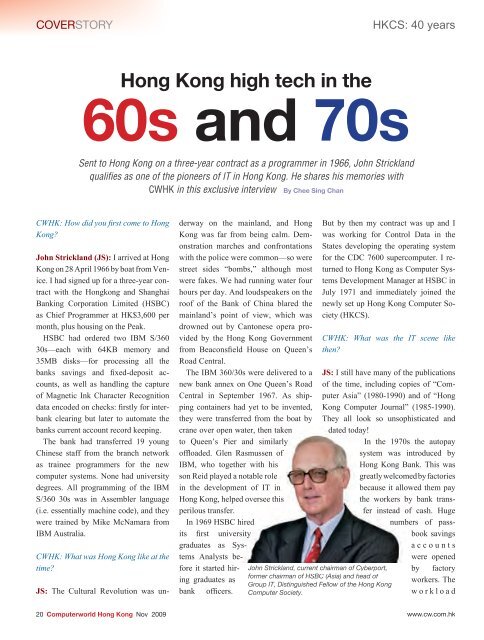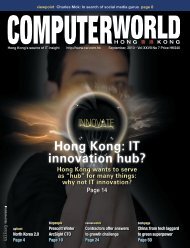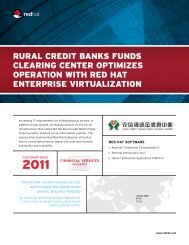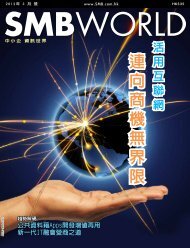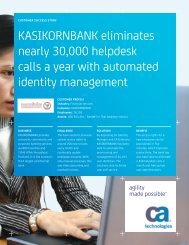Hong Kong Computer Society - enterpriseinnovation.net
Hong Kong Computer Society - enterpriseinnovation.net
Hong Kong Computer Society - enterpriseinnovation.net
Create successful ePaper yourself
Turn your PDF publications into a flip-book with our unique Google optimized e-Paper software.
COVERSTORY<br />
HKCS: 40 years<br />
<strong>Hong</strong> <strong>Kong</strong> high tech in the<br />
60s and 70s<br />
Sent to <strong>Hong</strong> <strong>Kong</strong> on a three-year contract as a programmer in 1966, John Strickland<br />
qualifies as one of the pioneers of IT in <strong>Hong</strong> <strong>Kong</strong>. He shares his memories with<br />
CWHK in this exclusive interview By Chee Sing Chan<br />
CWHK: How did you first come to <strong>Hong</strong><br />
<strong>Kong</strong>?<br />
John Strickland (JS): I arrived at <strong>Hong</strong><br />
<strong>Kong</strong> on 28 April 1966 by boat from Venice.<br />
I had signed up for a three-year contract<br />
with the <strong>Hong</strong>kong and Shanghai<br />
Banking Corporation Limited (HSBC)<br />
as Chief Programmer at HK$3,600 per<br />
month, plus housing on the Peak.<br />
HSBC had ordered two IBM S/360<br />
30s—each with 64KB memory and<br />
35MB disks—for processing all the<br />
banks savings and fixed-deposit accounts,<br />
as well as handling the capture<br />
of Mag<strong>net</strong>ic Ink Character Recognition<br />
data encoded on checks: firstly for interbank<br />
clearing but later to automate the<br />
banks current account record keeping.<br />
The bank had transferred 19 young<br />
Chinese staff from the branch <strong>net</strong>work<br />
as trainee programmers for the new<br />
computer systems. None had university<br />
degrees. All programming of the IBM<br />
S/360 30s was in Assembler language<br />
(i.e. essentially machine code), and they<br />
were trained by Mike McNamara from<br />
IBM Australia.<br />
CWHK: What was <strong>Hong</strong> <strong>Kong</strong> like at the<br />
time?<br />
JS: The Cultural Revolution was un-<br />
derway on the mainland, and <strong>Hong</strong><br />
<strong>Kong</strong> was far from being calm. Demonstration<br />
marches and confrontations<br />
with the police were common—so were<br />
street sides “bombs,” although most<br />
were fakes. We had running water four<br />
hours per day. And loudspeakers on the<br />
roof of the Bank of China blared the<br />
mainland’s point of view, which was<br />
drowned out by Cantonese opera provided<br />
by the <strong>Hong</strong> <strong>Kong</strong> Government<br />
from Beaconsfield House on Queen’s<br />
Road Central.<br />
The IBM 360/30s were delivered to a<br />
new bank annex on One Queen’s Road<br />
Central in September 1967. As shipping<br />
containers had yet to be invented,<br />
they were transferred from the boat by<br />
crane over open water, then taken<br />
to Queen’s Pier and similarly<br />
offloaded. Glen Rasmussen of<br />
IBM, who together with his<br />
son Reid played a notable role<br />
in the development of IT in<br />
<strong>Hong</strong> <strong>Kong</strong>, helped oversee this<br />
perilous transfer.<br />
In 1969 HSBC hired<br />
its first university<br />
graduates as Systems<br />
Analysts before<br />
it started hiring<br />
graduates as<br />
bank officers. <strong>Computer</strong> <strong>Society</strong>.<br />
But by then my contract was up and I<br />
was working for Control Data in the<br />
States developing the operating system<br />
for the CDC 7600 supercomputer. I returned<br />
to <strong>Hong</strong> <strong>Kong</strong> as <strong>Computer</strong> Systems<br />
Development Manager at HSBC in<br />
July 1971 and immediately joined the<br />
newly set up <strong>Hong</strong> <strong>Kong</strong> <strong>Computer</strong> <strong>Society</strong><br />
(HKCS).<br />
CWHK: What was the IT scene like<br />
then?<br />
JS: I still have many of the publications<br />
of the time, including copies of “<strong>Computer</strong><br />
Asia” (1980-1990) and of “<strong>Hong</strong><br />
<strong>Kong</strong> <strong>Computer</strong> Journal” (1985-1990).<br />
They all look so unsophisticated and<br />
dated today!<br />
In the 1970s the autopay<br />
system was introduced by<br />
<strong>Hong</strong> <strong>Kong</strong> Bank. This was<br />
greatly welcomed by factories<br />
because it allowed them pay<br />
the workers by bank transfer<br />
instead of cash. Huge<br />
numbers of passbook<br />
savings<br />
accounts<br />
were opened<br />
by factory<br />
workers. The<br />
workload<br />
John Strickland, current chairman of Cyberport,<br />
former chairman of HSBC (Asia) and head of<br />
Group IT, Distinguished Fellow of the <strong>Hong</strong> <strong>Kong</strong><br />
20 <strong>Computer</strong>world <strong>Hong</strong> <strong>Kong</strong> Nov 2009 www.cw.com.hk


